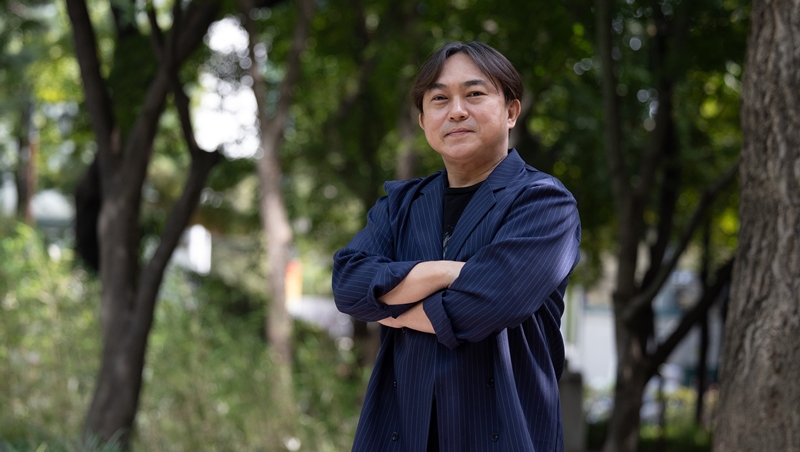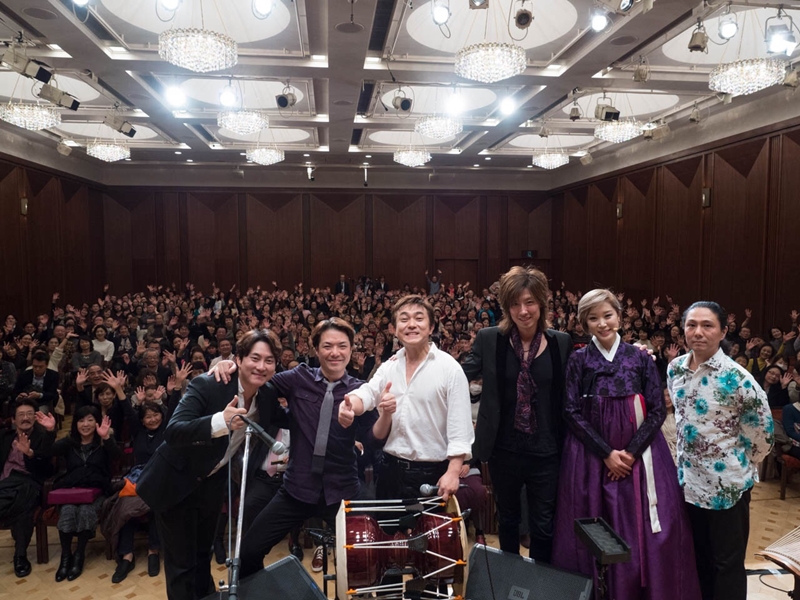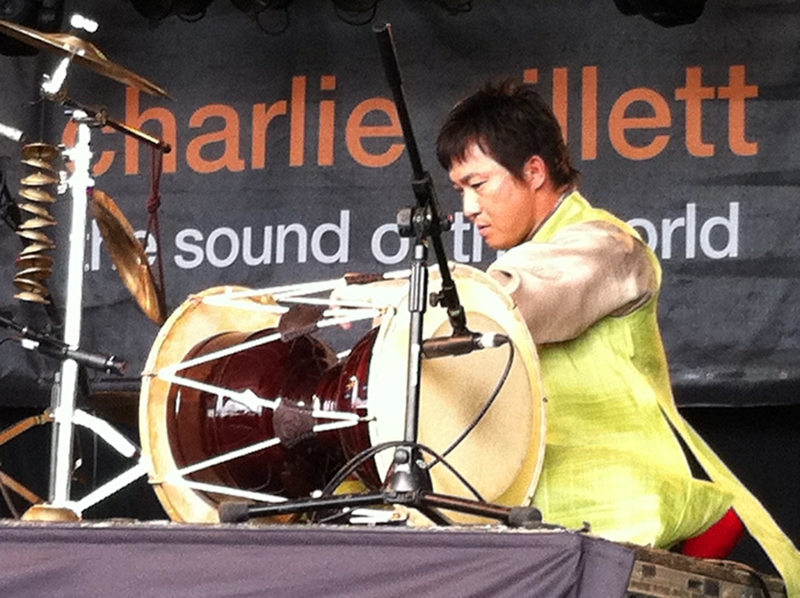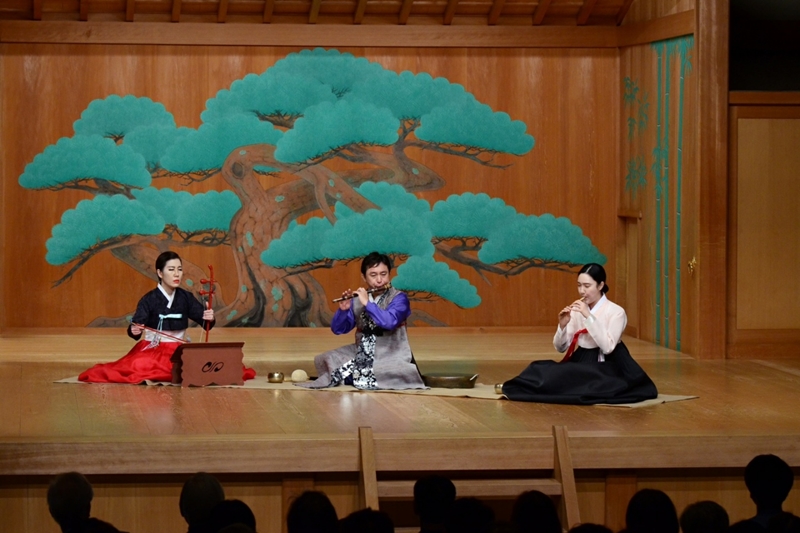
Min Yong-chi is a gugak (traditional music) musician and jaeil gyopo, or an ethnic Korean from Japan. (Lee Jun Young)
By Koh Hyunjeong of Korea.net and Kang Sung-chul of Yonhap News
"I find gugak (traditional music) to be the coolest thing. I'm pursuing fusion gugak because I want to promote tradition."
Min Yongchi, a third-generation jaeil gyopo (Zainichi or ethnic Korean in Japan) who has performed in both his motherland and its neighbor over the past 30 years, said this in a joint interview on Nov. 1 with Korea.net and Yonhap News.
Born in the Japanese city of Osaka, he moved to Korea after finishing middle school and enrolled at Gugak National High School. Later majoring in gugak at Seoul National University, he won the gold prize at the second World Samulnori Competition of traditional percussion music by playing the janggu (traditional drum).
The following year, he used the daegeum (bamboo flute) to place third at the same contest hosted by the Seoul daily Dong-A Ilbo. His prowess in music based on his awards could have earned him a spot on a gugak group after graduation but he chose a different path.
Min chose to become a soloist because he wanted to try new things and create freely. His latest project is to spread "shinhanak" (new Korean music), a genre he created by combining gugak and jazz.
The following are excerpts of a Nov. 1 interview with this musician, who spreads fusion gugak to reflect trends of the times in the hope of preserving the genre.

Fusion gugak musician Min Yong-chi (third from left) on Dec. 2, 2015, takes a photo after the performance "Shinhanak X Trisonic." (Min Yongchi)
How did you begin in gugak?
My father raised all four of his children as artists because of his own unfulfilled dream in music. So as the third child, I grew up in an environment where I was naturally exposed to music without being conscious of it.
Our small house was full of speakers that my father collected. My older sister majored in the gayageum (12-stringed traditional zither), my older brother in the piri (cylindrical double-reed bamboo oboe) and my younger sister in Korean dance. I don't think I could've experienced such a variety of arts in daily life had I grown up in a larger house.
Ethnic Koreans in Japan are part of a multicultural family, which I believe offers possibilities and competitive advantages. I teach Korean students at Ewha Womans University and Chugye University for the Arts, but given the opportunity, I want to bring Korean Japanese students to Korea to develop them into hybrid gugak musicians well-versed in both cultures.
Why did you start "shinhanak," or your version of fusion gugak?
I graduated from Gugak National High School and majored in gugak at Seoul National University, but Western music and gugak remained in my head. This is because I played the drums in a brass band in elementary and middle school.
I could've entered a gugak group after college but wanted to try converging Asian and Western music, so I chose the path of freelancer. Gugak is so addictive like thick cheonggukjang (stew made with strong fermented soybean paste) but its downside is that it's hard for novices to get into because it's very slow and difficult.
So I've tried in various ways for people in the modern age to feel the charm of gugak more easily. I've collaborated with pop acts such as Psy, Shin Hae-chul, Lee Moon-sae, Kang San-ae, DJ DOC, Roo'ra and Panic as well as famous classical musicians like Chung Myung-whun (conductor), Sumi Jo (soprano) and Yang Bang Ean (composer and pianist) to present fusion gugak.
Did you face difficulty in pursuing gugak as a Korean Japanese?
I've lived as a "border" person with two identities. Thanks to my identity as a Korean Japanese who is neither fully Korean nor Japanese, I could more freely interact with other music. Attempts that I find natural have been well received since they seem newer and fresher to others.

Gugak musician Min Yongchi from March 9-12, 2012, played the janggu (traditional drum) in New Plymouth, New Zealand, as part of the event World of Music, Arts and Dance - World of Music and Dance. (Min Yongchi)
How have your many performances abroad been received?
Actually, original gugak rather than fusion is in more demand abroad. The audience gets excited by the grandeur of gugak. Foreign audiences get immersed for hours in Jongmyo Jeryeak (royal ancestral ritual music of the Joseon Dynasty) or sinawi (traditional improvisational music) and give standing ovations.
They never get bored or tired because gugak is something of ours that they can never imitate. In the case of Japan, the fervor for noh (classical Japanese dance-drama) abroad is so strong that tickets for performances are sold out months in advance.
Responses to dance or performing arts abroad are far more positive rather those to songs with lyrics. This is because of the limit to conveying a message through song even with subtitles and the many cases of similar types of music out there despite slight differences in vocal styles.
What performance or activity do you remember most?
I took part in the Korean Heritage Camp (for Korean adoptees) 13 times from 1996 to 2011 in Denver, Colorado, and played samulnori (traditional percussion music) each time. I still vividly remember the children who cried and grabbed my pants, saying, "Please put me in a bag and take me to Korea."
Me as an Asian man playing gugak embedded with Korean DNA apparently touched the children growing up in a white society about their roots, something they seemed to be always curious about.
Gugak has the power to instill pride in one's roots and identity. Every time I see children excited while listening to our traditional music, I feel that I did well by playing gugak.
What would you like to ask the audience?
Approach the arts with a completely open mind and remove prejudice. Artists do not compete. Even if genres are different, we work together as one to create quality works and enrich the hearts of people.
What are your plans?
In December, I will perform in "World-resonating Arirang" in Seoul. For the upcoming 25th anniversary of the Korean Cultural Center in Osaka, Japan, in April next year, I will collaborate with a creative troupe from National Gugak Center of Korea at the Symphony Hall in Osaka.
I've tried various things like fusion collaborations to promote tradition, but since I'm now over 50 years old, I think it's time for me to slowly promote "original tradition" that I really want to do.
So the plan is to perform with samulnori maestro Kim Duk-soo in October next year in Tokyo and tour four cities -- Fukuoka, Osaka and Tokyo in Japan and Seoul -- in November of the same year to perform gugak with Japanese noh on a creative stage.
I plan to take the lead in getting audiences at performances immersed in gugak's appeal and for them to come again and stimulating the music and copyright markets to help musicians in the genre to assert their rights.

Gugak musician Min Yongchi (middle) on April 20, 2019, plays the daegeum (bamboo flute) at the performance "Manhangga" held at National Noh Theatre of Japan Arts Council in the Shibuya district of Tokyo, Japan. (Min Yongchi)
hjkoh@korea.kr